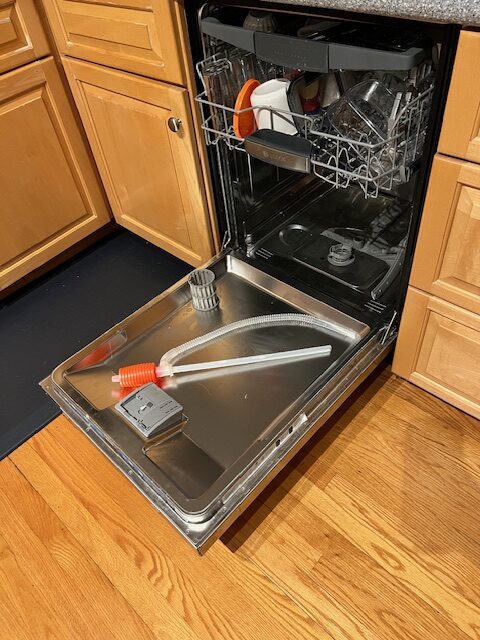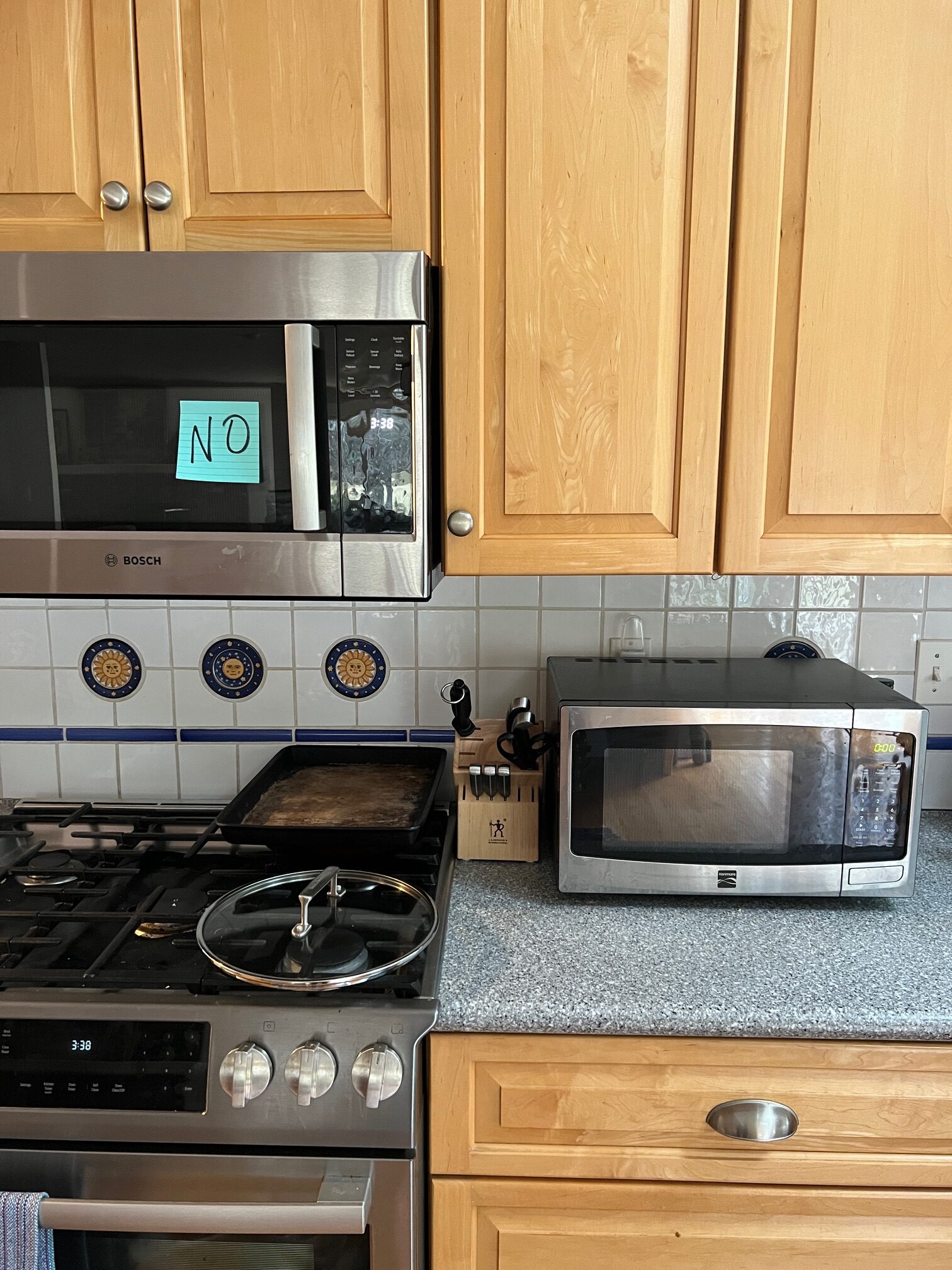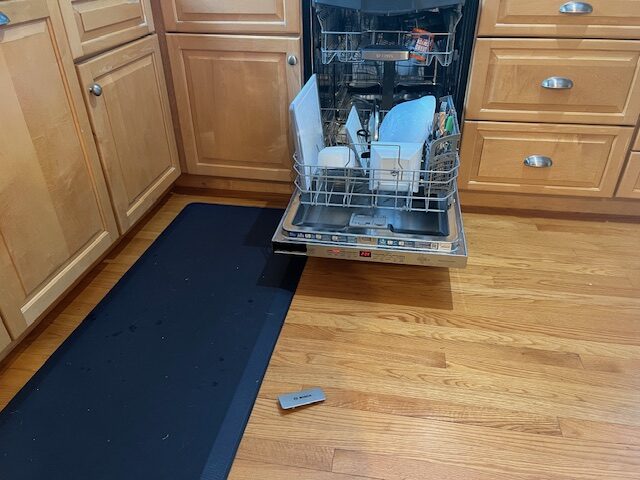
Has anyone but us noticed that a lot of things, such as major appliances, don’t work well or last like they used to? A great example (unfortunately for us) was our dishwasher and our microwave. They both are a German brand (Bosch), so we figured they’d work well and last, thanks to their high price, but that’s not what happened.
Our Microwave was the first casualty. Actually, before that–we had the full set of appliances just a few months when the ice maker on the fridge had to be replaced due to low performance, but even with the new ice maker, we’re constantly borrowing ice from my mother in the warm months. And, the stove is a big jerk, too. Since it was about 18 months old, it’s been disinterested in any temp that starts with a 4. As in, 395 is fine and broil is fine, but if we try to use it at any temperature in the 400s, it errors out and displays a phone number we should call.
Back to our current issue–the door to the microwave is flimsy, and bends slightly when you open the door. This results in the fuses blowing, since there are fuses associated with microwaves that require synchronicity. When one fuse is ‘on’ the other must go ‘off’ at the same time (why, I don’t know, but it’s on the Internet if you’re curious). When the door bends ever so slightly, boom….we blow a fuse because the fuses are out of sync.

So we called a repair person. No luck there. It’s a common problem, and as usual, it’s cheaper to just buy a new one than fix the old one. We did neither, but rather left the non-working microwave in place (we’ll replace it with a vent fan eventually) and just bought a “cheapo” smaller one and sat it on the counter. That one works fine, for now, and when it dies we’ll just toss it in the trash.
As annoying as the microwave was, the dishwasher was worse. About every tenth time we tried to wash the dishes we got an error code, such as E15 or E24. We’d look those up on the Internet, watch a couple videos to find one where the narrator seemed to know what he was talking about, and then try to follow the directions, which usually involved taking the filter pieces apart and removing some small piece of food, like a grain or two of rice, that was lodged somewhere in the filter mechanism.

The situation got so bad that it was almost easier to just wash dishes in the sink. The solution to the dishwasher was straightforward, and improved the process. These errors arise because of government regulations to conserve water. That’s why a dishwasher takes two hours to finish a cycle–because it uses the same water over and over, which requires many trips through the filter for that same water, eventually clogging the filter.
To add insult to injury, someone walking by the dishwasher (a.k.a. ‘not me’ — there’s one of these in every household) must have gotten their pantleg stuck on the part of the dishwasher door with the logo, so that is frequently found on the floor.
Now we’re in favor of clean water as much as anyone, but this was incredibly annoying, particularly since we’re on a well and septic–the water comes in from our well and goes right back out to the leach field where it rejoins the water table.
The good news here is that this problem is easily fixed, at least temporarily. All you need to do is run the dishwasher on “speed cycle”. When you do that, the dishwasher cleans your dishes just like they used to–using enough water, getting done in about an hour, and no more error codes. Since then we’ve realized that this idea applies to almost all appliances in some way or another–government regulations require meeting certain standards such as water usage and energy efficiency, but importantly, ‘in the state of the appliance when shipped from the factory’ (that’s the only place to really check it). That’s why if you just turn on the dishwasher it doesn’t work right, but the selection is available to make it work properly. You just have to understand what’s going on.
This applies to all sorts of things. For instance, I have a speedy looking German car that drives like a turtle. However, all I have to do is put it in “sport mode” and it drives as it was intended. The car simply had to meet mileage/fuel economy standards in its default condition, when it left the factory. This applies to our washing machine too–looks great, lots of fancy electronics, but it takes hours to wash a load of laundry. Just use the speed cycle, and presto, it’s done and the clothes are probably cleaner.
Perhaps a bigger problem with these outsourced appliances made in cheap labor countries, is that they don’t last, regardless of how you treat them. The German appliances we purchased weren’t built in Germany, but perhaps in some cheap labor country like China. Sometimes extremely expensive appliances might be made in the US or in Germany, but the problem with 99% of appliances is that most are manufactured in the countries with the lowest labor costs. If you really delve into it, there are all sorts of problems caused by this situation. First of all, the products aren’t made to last or be repaired. We bought a famous brand, top of the line washing machine and dryer a few years ago, and had to recently buy new ones, yet again, because the old ones broke and weren’t fixable. In fact, we had to pay someone to lug them out of our basement. Washing machines used to last forever.
So in the case of appliances and no doubt more, “offshoring” is causing all sorts of problems:
1) High paying union type jobs are gone here in the US, and in some countries to which we outsource, child labor is employed.
2) The environment is far worse off because the cheap labor countries pollute more than we do, often dumping waste directly into rivers or the ocean (Google “trash rivers in India” if you want to see an apocalyptic landscape). Many rivers are so covered in plastic trash floating along towards the ocean, that absolutely no water is visible.
3) We have to toss appliances more quickly now because they break and aren’t worth fixing, filling up landfills and wasting resources.
4) Worst of all, these appliances are shipped here on giant container ships that consume huge amounts of fuel, more than negating whatever efforts have been made to combat pollution and climate change. The newer ships, now able to get through the enlarged Panama Canal (these ships are called “New Panamax”), need to carry an absolutely extraordinary amount of fuel–between 2.5 million to 3.5 million gallons of fuel. And these ships don’t lug around fuel they’re not going to burn, so this is how much fuel they’re using to bring these appliances (and more) here. These boats consume 30,000 to 90,000 gallons of fuel per day, depending upon speed–so, if they go slower they’ll use less fuel per day, but they’re burning fuel for more days. According to Mr. Internet, a Panamax container ship uses 128 tons of fuel per nautical mile! Also from the Internet, so take it with a grain of salt (it’s so terrible it seems impossible, but I checked–it’s apparently true), the 16 largest cargo ships produce more climate changing pollution than all the world’s cars. This is due to both how much fuel is used, but also what type of fuel. These giant ships burn high sulfur fuels made from the heavy residue left in refineries–fuels that are not allowed to be used on land.
5) And, once products arrive in port, they still must be unloaded, picked up by trucks that have often been idling for long periods of time, waiting to pick their loads, which are then delivered all across the country.
And to add insult to injury, these appliances actually cost more than if they were made here in the USA, because you have to buy them multiple times. Our inflation calculations don’t take ‘time’ into account (how many times you have to buy something in a period of time). We’re certainly not saving any money or helping the environment by purchasing things from overseas that fall apart, are not repairable, and end up in the landfills or the ocean.
We just replaced the Bosch dishwasher with a Fisher & Paykel Dishdrawer. That’s going to take some getting used to!



